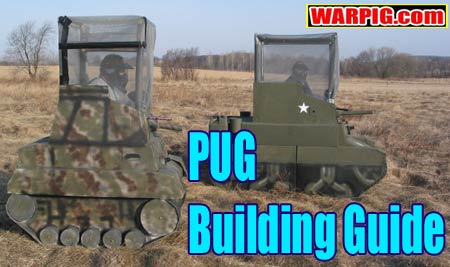  |
|
|
|
|
|
|
  |
|
|
|
|
|
|

What do you think? Add your comments in WARPIG's REC TALK Forum
|

PUG Building Guide By Bill Mills - Sept 2003 PUG Photos courtesy Stone Gryphon Studios
Paintball insurance restrictions in 2001 caused a number of scenario promoters to either prohibit motorized tanks at their games or require additional insurance fees of as much as $100 per tank per event to allow them on the field. This change opened up some new insurance companies to scenario ball, which did allow paintball tanks without an extra fee, but also gave some players a reason to turn to human power for their paintball vehicles. The Gryphonians, a scenario team based out of Wisconsin turned their focus on designing a paintball tank that was not only human powered, but was small, light and inexpensive enough that they could bring an entire platoon of them to a scenario game, while still performing the scenario functions of a paintball tank.
While the PUG looks like a miniature version of a WW-II era tank in general form, it’s pilot is only protected from mid torso down by the tank shape itself. The internal wooden framework extends up above the mock turret area to hold netting so that the player is protected from the volumes of paint, which typically fly at a paintball tank in a scenario game. As the PUG is used from a standing position, a normal “shooting from the hip” posture puts the player’s paintgun right in a front positioned gun port, allowing them to charge at a walking pace against a fortified objective.
The PUG is not what most players think of when they hear “paintball tank” but represents a much less expensive alternative to fill many of the same scenario roles, and the PUG Building Guide can take a player from start to finish in building a PUG of their own.
|
| Copyright © 1992-2019
Corinthian Media Services. WARPIG's webmasters can be reached through our feedback form. All articles and images are copyrighted and may not be redistributed without the written permission of their original creators and Corinthian Media Services. The WARPIG paintball page is a collection of information and pointers to sources from around the internet and other locations. As such, Corinthian Media Services makes no claims to the trustworthiness or reliability of said information. The information contained in, and referenced by WARPIG, should not be used as a substitute for safety information from trained professionals in the paintball industry. |